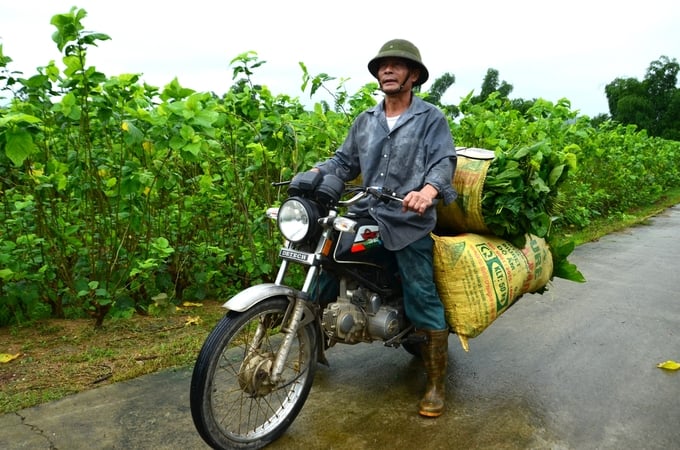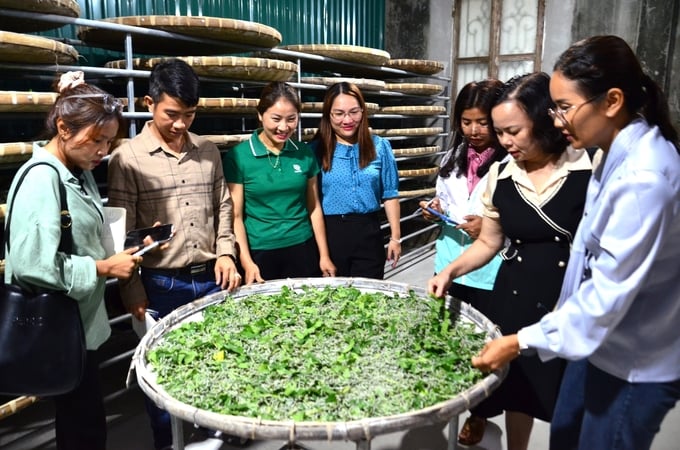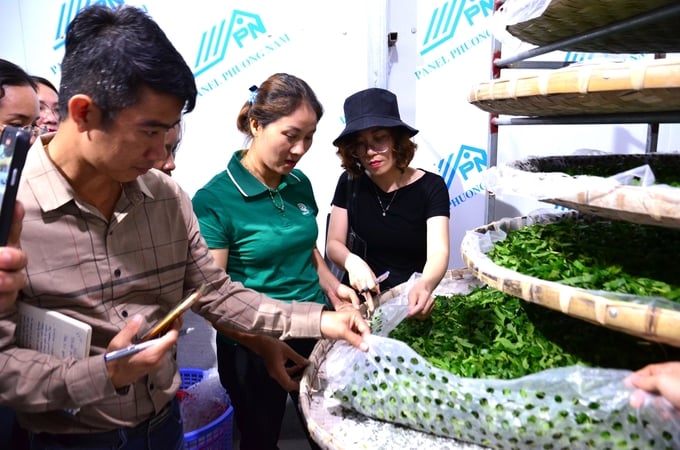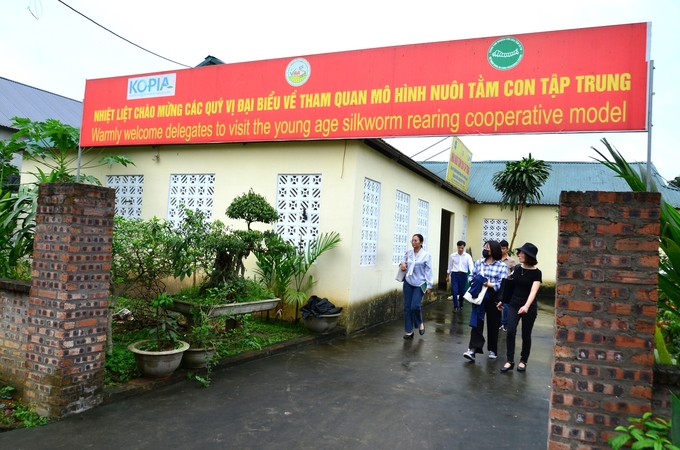December 1, 2025 | 11:18 GMT +7
December 1, 2025 | 11:18 GMT +7
Hotline: 0913.378.918
December 1, 2025 | 11:18 GMT +7
Hotline: 0913.378.918

Transporting mulberries from the yard. Photo: Duong Dinh Tuong.
Dr. Nguyen Thi Min, Deputy Director of the Central Mulberry Research Center, said that recently, KOPIA Vietnam has supported the project to develop the value chain of growing mulberry and raising silkworms in Yen Bai province.
At the end of the project, through evaluation, the efficiency of growing mulberry and raising silkworms was 3-4 times higher than growing rice, so KOPIA Cambodia also had the idea to develop this profession, and at the same time sent 4 officers from the General Department of Agriculture to study.
During one week in Vietnam, Cambodian students learned about mulberry growing techniques, mulberry disease prevention techniques, silkworm raising techniques, silkworm disease prevention techniques, and silk reeling techniques. They had a field trip to Tran Yen district, Yen Bai province. Currently, Cambodia only has a few dozen hectares of strawberries. Still, after returning from studying in Vietnam, they will propose to KOPIA to expand the area if they find it suitable.
Mrs. Hoang Thi Ha, Lan Dinh area, Viet Thanh commune, was busy picking mulberries and shared that when it rains like this, after bringing mulberry leaves home, she has to spread them on the floor, turn on the fan to dry them, and then feed them so that the silkworms don't get sick.
Looking at the baby silkworm nests arranged on racks, the Cambodian staff curiously asked how to clean them and were told that it was simply a matter of lining a piece of nylon with a hole punched in it and, when it was full, lifting it and you're done.

Mrs. Le (third from left) introduces Cambodian agricultural officials to the concentrated raising of silkworms. Photo: Duong Dinh Tuong.
Mrs. Le has been familiar with growing mulberries and raising silkworms since she was young. After getting married, she seemed to have a break from the profession and did not return until 2015. At first, she planted 1 acre of strawberries and then rented more land, growing it to 4 hectares, but in the past two years, due to the high price of cocoons, people wanted the land back to raise themselves, so it was reduced to 3 hectares. Even though the silk industry has ups and downs, many people are discouraged and abandon their mulberry trees, but she still perseveres and holds on because, compared to growing corn, growing rice is better.
In 2023, she decided to establish a cooperative. The cooperative has 56 members in Viet Thanh commune and is affiliated with households in Van Chan District, Van Yen District, Yen Bai Province, and Tuyen Quang Province.

Replacing silkworm manure is simple; use a perforated plastic sheet underneath. Photo: Duong Dinh Tuong.
The family grows a lot of mulberries, so if she can't raise only baby silkworms, Mrs. Le raises adult silkworms as well. Last year, her family sold silkworms and cocoons for VND 700 - 800 million, of which about 60% was invested, and the rest was profit.
If you raise silkworms in hot water, you have to feed them 5-6 meals a day and change the manure every day, but since 2003, there has been technology to raise silkworms on the floor, only feeding them three meals a day and having to change the manure every few days.
Unlike the traditional silkworm farming house used by the people, it is a model concentrated silkworm rearing house with spacious corridors and open spaces to avoid direct sunlight causing heat. The house is divided into rooms such as mulberry room, baby silkworm rearing room, large silkworm rearing room...
This model silk house was designed by the Central Mulberry Research Center and built in 2019 for Viet Thanh Mulberry Cooperative, with a total value of VND 770 million. An area of 300 square meters can provide enough silkworm breeds to produce about 20 hectares of mulberries.

Model concentrated silkworm raising house. Photo: Duong Dinh Tuong.
Dr. Nguyen Thi Min, Deputy Director of the Central Mulberry Research Center, said that the mulberry growing area in Korea is very small, so you want to invest in Vietnam to develop mulberry trees and create deep processing products.
Bao Dap, Viet Thanh, and Quy Mong are communes in Tran Yen district that are part of the KOPIA program that Korea has built a model for the period 2020 - 2022. Specifically, your side has supported strawberry varieties, training, and construction. Build a centralized silkworm-rearing facility, raise silkworms on shelves in air-conditioned rooms, and replace bamboo poles with wooden poles.

Mulberry growing area on the riverbank of Viet Thanh commune. Photo: Duong Dinh Tuong.
Regarding mulberry varieties, previously planted with cuttings had the disadvantage of a poorly developed root system. Now grown with seeds, the root system is deep, wide, resistant to falling, and has good regeneration ability when flooded. The Central Mulberry Research Center has bred mulberry varieties grown with seeds VH13, VH15, VH17, GQ2, GQ12, and GQ20 to transfer to the Northern provinces, particularly Yen Bai.
Regarding the two-stage silkworm farming technology, in the past, farmers raised silkworms from when the eggs hatched until they were eaten and cocooned. Still, now they are divided into two stages: the first is to raise silkworms intensively from the first year to the end of the third year. Households can raise 100-150 egg circles, one batch per week.
The second is to buy large silkworms from age four to raise, only 10-12 days to make cocoons. In recent years, the Korean KOPIA Center has supported the technology of raising silkworms on multi-story shelves. Instead of raising 1 round of silkworm eggs using about 16m2 of floor space, the same area for raising silkworms on 3-4 floors can be increased 3 - 4 times. In humid weather conditions, raising silkworms on racks can limit disease.
Translated by Huong Giang

(VAN) The signing of a protocol between Viet Nam and China on the export of fresh jackfruit represents a significant milestone in agricultural trade cooperation between the two countries.

(VAN) On November 27, the Ninh Binh Department of Agriculture and Environment and the Institute for Green Growth Research organized a training course on greenhouse gas inventory for businesses.

(VAN) China’s cooking oil is suddenly flooding into India. It all comes down to a soybean surplus that Beijing doesn’t quite know what to do with.

(VAN) An Giang promotes supply-demand connections, standardizes quality and builds value chains, creating a foundation for sustainable bird’s nest development and aiming to expand exports.
/2025/11/24/5339-4-nongnghiep-075331.jpg)
(VAN) Recently, the conference on 'Sustainable Fisheries Linkage Chain - Tilapia for Export' took place in Tien Hai commune, Hung Yen province.
/2025/11/21/4309-2-153400_128.jpg)
(VAN) Green and low-emission rice is paving the way for Vietnamese rice to enter high-end markets, marking the beginning of a transformation journey toward greening and elevating the national rice brand.

(VAN) ‘Right to Win’ outlines a national action plan that shapes a new vision for Viet Nam’s agriculture in an era of renewal and global integration.